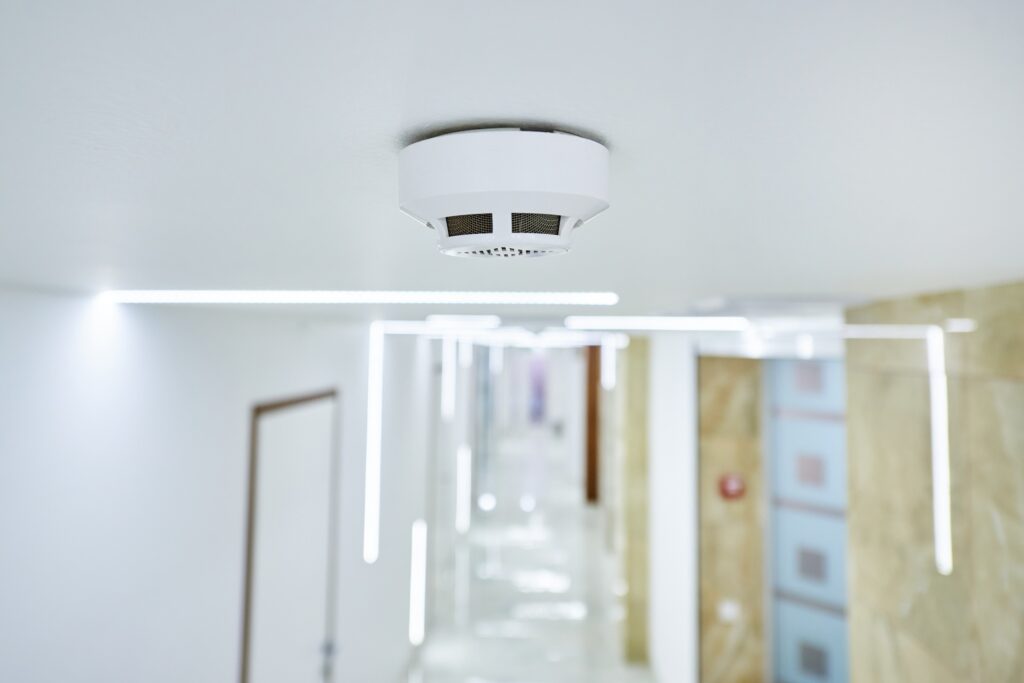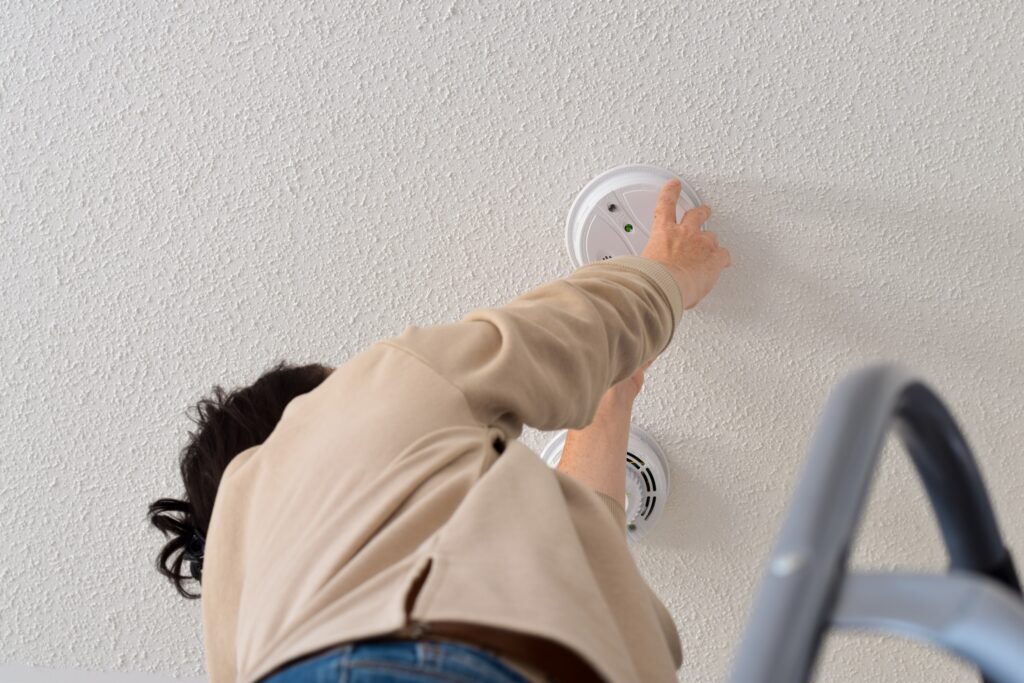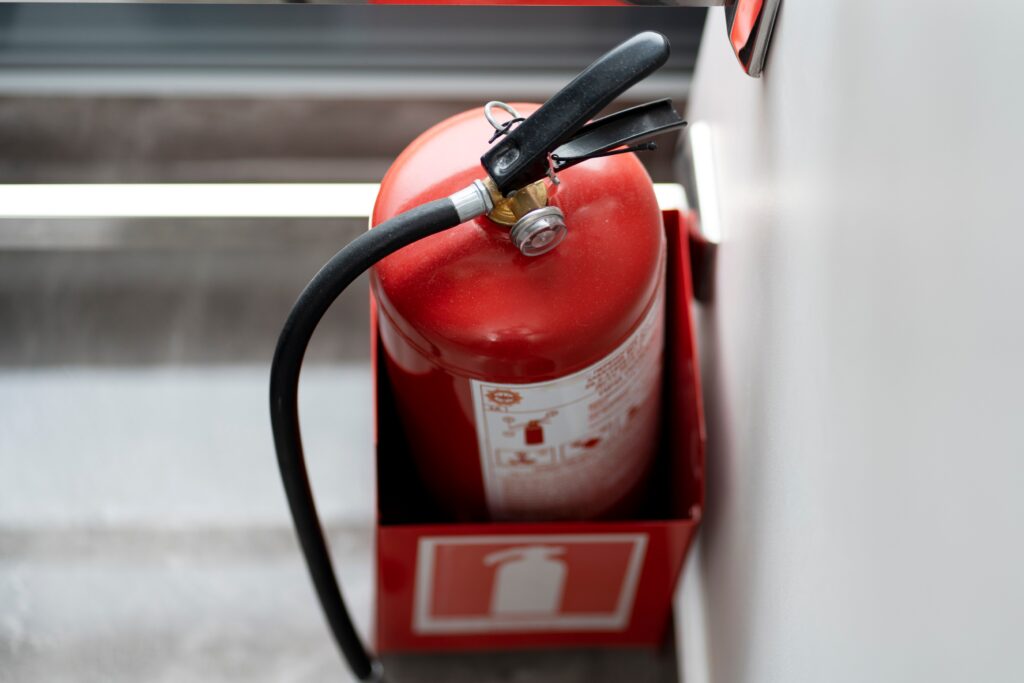Smoke detectors are more than just beeping gadgets—they are lifesavers. In the event of a fire, these devices provide the crucial early warning needed to escape safely. But simply having smoke detectors isn’t enough; their placement is key to ensuring they perform their life-saving duty effectively. This guide will help homeowners understand the best locations to put smoke detectors for optimal safety.
What Are Smoke Detectors?
Smoke detectors are devices that detect smoke, usually indicating a fire. They contain sensors that detect smoke or vapor particles in the air and trigger an alarm in a specific area. Smoke detectors can be analog or digital, traditional, adjustable, or smart. While they can sometimes produce false alarms, especially if food is frequently burned, their primary function remains vital.
Types of Smoke Detectors
There are three types of smoke alarms: ionization, photoelectric, and a combination of the two, which is commonly called a “dual” detector.
Ionization Smoke Detectors
Ionization smoke detectors are designed to detect the fine particles of smoke produced by flaming fires, such as those caused by paper or grease. These detectors contain a small amount of radioactive material between two electrically charged plates, which ionizes the air and creates a flow of current between the plates.
When smoke enters the detectors chamber, the ionization smoke detector disrupts this flow by attaching to the ions, reducing the current, and triggering the alarm.
Ionization smoke detectors are typically more responsive to fast, flaming fires but can be less sensitive to smoldering fires or dense smoke particles. Therefore, they are often recommended in combination with photoelectric detectors to provide comprehensive fire detection in a home.

Photoelectric Smoke Detectors
Photoelectric smoke detectors use a light beam and a light-sensitive sensor. Inside the detector, there is a light source aimed away from the sensor. When smoke enters the chamber, it scatters the light, redirecting it towards the sensor. The sensor detects this increase in light and activates the alarm.
Both types of smoke detectors mentioned above are effective, but they react to different types of fires. Ionization detectors are generally faster at detecting flaming fires, while photoelectric smoke alarms are quicker at sensing smoldering fires. For comprehensive safety, many modern smoke detectors combine both technologies.
Combination Ionization and Photoelectric – Dual Detectors
Dual detectors aim to provide the best of both worlds by combining ionization and photoelectric technologies. They are often recommended for comprehensive fire detection as they can detect a wide range of fires. However, it is essential to note that even with dual detectors, certain types of fires may still go undetected.
Where to Place Smoke Detectors?
The placement of smoke detectors is crucial for early warning and evacuation during a fire.
The National Fire Protection Association (NFPA) recommends having at least one smoke detector on every level of a home, including basements and attics, and inside each bedroom or sleeping area. In addition, smoke detectors should be placed in hallways and stairs leading up to bedrooms and common areas like living rooms and kitchens.
Specifically, smoke alarms should be placed on the ceiling or high on a wall but no closer than four inches from the corner where the wall meets the ceiling. This positioning allows for optimal coverage and reduces the chance of false alarms caused by cooking smoke or steam.
Best Locations for Smoke Detectors
Bedrooms
Every bedroom should have a smoke detector. Most deadly fires occur at night when people are asleep, so placing a smoke alarm inside each bedroom ensures that everyone gets an early warning. For an added layer of safety, install a smoke detector in the hallway and outside bedrooms.
Kitchen
The kitchen is a common place for fires to start, but it’s also a location prone to false alarms from cooking smoke. Install a photoelectric smoke detector at least 10 feet away from cooking appliances to minimize false alarms while still providing protection.
Living Rooms
Living rooms often contain many combustible materials, such as furniture, curtains, and electronics. Installing a smoke detector in this area can quickly detect fires originating from these sources. Place the detector on the ceiling for optimal performance, as smoke naturally rises.
Hallways
Install smoke detectors in hallways that connect bedrooms to other parts of the house. These locations serve as pathways to safety and should be equipped with detectors to ensure a clear escape route.

Where Not to Install Smoke Detectors?
While smoke detectors should be installed in multiple locations throughout a home, there are certain areas where they should not be placed. These include:
- Bathrooms: High humidity and steam from showers can trigger false alarms.
- Garage: Car exhaust and fumes can interfere with the detector’s sensors.
- Near Fans or Air Vents: Air movement may disrupt the detection of smoke particles.
- Extreme Temperature Areas: Avoid placing detectors in locations that experience temperatures below 40°F or above 100°F, such as outdoor rooms, unfinished basements, or attics.
- Close to Cooking Appliances: Position detectors at least 10-20 feet away from stovetops or ovens to prevent false alarms from cooking smoke.
- Insect-Prone Areas: Bugs or insects can cause false alarms by crawling inside the detector.
- Near Fluorescent Lights: Keep detectors at least one foot away from fluorescent lights, as the emitted light can interfere with photoelectric detectors.
What You Need to Know Before Installing Smoke Detectors
Now that you know where to put smoke detectors (and where not to), there are a few other things to consider before installing them in your home.
Mount Them Up High
Smoke and heat rise, so mounting smoke detectors on the ceiling or walls is the best option for maximum protection. If this isn’t possible, mount them high on a wall, at least 4 inches from the ceiling.
Interconnect Your Smoke Alarms
For optimal protection, interconnect your smoke alarms so that when one alarm activates, they all do. This can be achieved through hard-wiring or wireless technology. It’s crucial that all interconnected smoke alarms come from the same manufacturer to ensure compatibility; otherwise, they may fail to function correctly.
Keep Them Away from Obstructions
Make sure to keep the area around your smoke detectors clear of any obstructions, such as furniture or decorations. These can block the detection of smoke and delay the alarm.
Avoid Painting Them
Do not paint your smoke alarms. Painting can cover up the vents and sensors, making them less effective in detecting smoke particles.
How Many Smoke Detectors Do I Need?
The number of smoke detectors needed for a home depends on its size and layout. As a general rule, at least one smoke detector should be installed on every level, including basements and attics, and inside each bedroom or sleeping area.
Additionally as previously mentioned, it is recommended to have interconnected smoke detectors throughout the house so that if one is triggered, all of them will sound simultaneously. This ensures that everyone in the house is alerted to a potential fire, regardless of their location.
Smoke Alarms Maintenance Tips
Proper placement of smoke detectors is crucial, but regular maintenance is just as critical. It is recommended that smoke detectors be tested at least once a month and batteries replaced twice a year. In addition to this, the NFPA recommends replacing smoke detectors every ten years, even if they appear to be functioning correctly.
Regular Testing
Test your smoke detectors at least once a month. Most models come with a test button that you can press to ensure the alarm sounds. This simple step can save lives by ensuring your detectors are always ready to alert you in case of a fire.
Battery Replacement
Change the batteries in your smoke detectors at least once a year. A good rule of thumb is to do this when you change your clocks for daylight saving time. Some modern detectors come with long-life batteries that last up to 10 years, but it’s still crucial to check them regularly.
Cleaning
Dust and debris can interfere with a smoke detector’s operation. Clean your detectors at least once a year using a vacuum cleaner with a soft brush attachment. Avoid using harsh chemicals that could damage the sensors.

What Other Fire Safety Measures Should I Take?
While smoke detectors are an essential part of any fire safety plan, you should consider additional measures to protect your home and loved ones. These measures include installing carbon monoxide detectors, having fire extinguishers, creating an evacuation plan, and strategically placing fire blankets.
Carbon Monoxide Detectors
Carbon monoxide (CO) is a colorless, odorless gas that can be deadly if inhaled. A carbon monoxide alarm is designed to alert you when levels of this dangerous gas reach a certain level in your home.
Fire Extinguishers
Having at least one fire extinguisher in your home can help you contain and put out a small fire before it becomes more significant. Make sure they are easily accessible and that you learn how to use them correctly.
Create an Evacuation Plan
In case of a fire, having an evacuation plan in place can save lives. Make sure everyone in the household knows how to leave the house quickly and safely, and designate a meeting point outside.
Fire Blankets
One often overlooked yet highly effective fire safety tool is the fire blanket. Designed to smother small fires by cutting off the oxygen supply, fire blankets can be invaluable in the early stages of a blaze. They are particularly useful in the kitchen, where grease fires can quickly get out of hand and should not be extinguished with water.
Thinking of buying one? Mart Cobra offers emergency fire blankets made from high-grade 430+ GSM 100% fiberglass fabric. Our fire safety blankets can withstand extreme temperatures up to 1076°F, ensuring robust and reliable protection. Meeting rigorous safety standards set by CE and SGS, these fire blankets are an indispensable addition to any comprehensive home survival kit.
Checking Electrical Systems Regularly
Faulty wiring is a common cause of house fires. Have an electrician inspect your home’s electrical system at least once every few years to ensure it is up to code and functioning correctly.
Keeping Flammable Materials Away
Make sure to store flammable items, such as gasoline or paint, in a safe location, away from any potential ignition sources.
Conclusion
Smoke detectors are an essential safety feature for any home. By understanding how they work, where to place them, and proper maintenance, you can ensure that your family stays safe in case of a fire. Additionally, incorporating other fire safety measures such as carbon monoxide detectors, fire extinguishers, and an evacuation plan can further protect your home and loved ones.
Take a moment today to assess your home and ensure your smoke detectors are in the right places and in good working condition. Remember always to be vigilant and take necessary precautions to prevent fires from happening.

0 comments